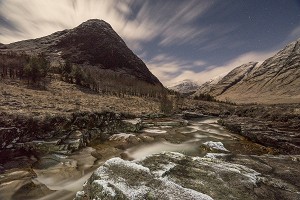
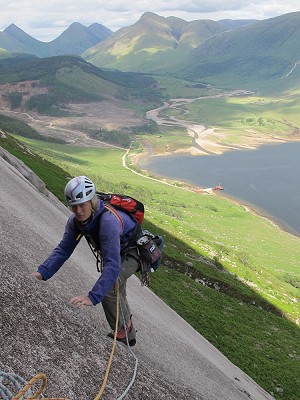
The signs were promising. The weather was perfect; we had chosen a 4 star E1 with multiple 5b pitches, at least one of which should suit my positive ape index; and, unusually, we weren't last to arrive at the crag.
But there were negatives too. I was recovering from a virus which had laid me low for most of the previous month; the walk in had felt extremely challenging (even at our gentle pace, which as usual doubled the guidebook time); and there was the mild inconvenience that I don't actually like slabs.
But the biggest concern was the clear recollection both of us had of a vow we made some 19 years before. Then, on our only previous visit to Glen Etive, we'd made a smooth, efficient ascent of Pinch Direct. Yet despite the epic-free nature of that fine Spring Day in 1993, when we made it back down to the car, we vowed we would never return. The only problem was that with the passing of time, though we could clearly remember making that pact, neither of us could quite remember why we'd felt that way...
And so this time around we chose carefully, eschewing big numbers for something which should have been well within our capability, whilst maintaining a standard where leading through should be both practical and enjoyable.
As luck would have it, Clare declared she would lead off. This wasn't the statement of bold intent it appeared. With meticulous foresight, she had consulted the guidebook, found the pitch containing the long reach, and simply counted back to make sure she didn't end up leading that one.
I was happy with her choice - even more so when her only runner, a psychological alien in a suspicious pocket at 20ft, suddenly fell out as she moved past it.
Had that been me, I'd have been wobbling back down as quickly as I could, but Clare later admitted that the prospect of ignominious retreat was made even less palatable by a feeling (incorrect as it happens) that everyone standing round the bottom of the crag was watching her! Instead she kept her cool, deployed "Spotty Dog" technique (any Woodentops aficionados?), and padded up to the corner and some very welcome first runners.
After this extremely bold entrée, the rest of the pitch appeared straightforward, and Clare was quickly at the belay. I started off in confident mood, but when I arrived at that first all-out padding sequence – unprotected, essentially holdless and 20ft up, I was horrified. This feeling was compounded when all at once the memories of Pinch Direct came flooding back, and suddenly the vow we had made that day made complete sense.
A little shell shocked, I somehow made it through the smearing sequence and hugged the corner above with relief. The rest of the pitch was easy, but it had been an impressive lead by Clare and not one I could have contemplated straight off the deck.
Fortunately Pitch 2 was not only much more amenable, it was also one of the best and cleanest slab pitches I have done anywhere in the mountains. Pulling into an easy flake and groove, I soon quit this for a niche on the slab to the left. The only feature in the blank wall above was a quartz band which ran out leftwards, towards less steep ground. A technical rockover saw me standing on the sloping quartz shelf and I then 'walked' left along it, just in balance but with no handholds for reassurance, to the sanctuary of easier ground. This was a superb piece of climbing following a fortuitous natural feature, and a really elegant solution to an apparent blind alley.
From the end of the quartz band, an easy sequence of ribs, flakes and little shelves led up left to the base of a sharp edged corner. This looked tricky, and I was grateful to slot in a bomber nut at its base – the first for some time. Fortunately looks were wholly deceptive, and the corner was actually very easy, leading to a comfortable belay complete with situ thread and screwgate krab.
Clare soon joined me on the stance, and we surveyed the roof above. After a short recce to examine the lip, Clare executed a neat mantle and disappeared rightwards along the lip (though not before fixing me a decent runner out left – something for which I would soon be very grateful).
Clare took a long time sorting the next belay, but then it was my turn to discover why there was a substantial ab point in situ on the stance just below the roof. A long juggy rail on the lip was initially encouraging, until I realised there were no holds whatsoever on the slab above. I certainly couldn't press out a mantle like Clare, so I resorted to lying on my side in the lip-gutter, and doing a sort of sideways one-armed press-up. It wasn't elegant, but it was effective, and as I stood up I found myself musing on the fate of HVS leaders on Swastika (a onetime HVS) which also crosses the roof here. I decided that the difficulty of that move, and the situ thread and screwgate on the stance below, were probably not un-related.
Arriving at Clare's stance on a narrow ledge with a flake to its right, I could see why she had taken a while to sort the belay. She had got several equalised nuts in, but none looked perfect, so I supplemented her effort with the Friend 1.5 I had used in the previous belay.
Clare read the description – "traverse left for 3m and go up past a quartz pocket". Higher up, this pitch would also feature the Long Reach move Clare was so keen to avoid.
I made the unprotected traverse and looked for a pocket in the rippled blankness above, but all I could see was a series of rising, undulating bands. I balanced upwards on not a lot, before spotting a pocket out left. It was small, perhaps two finger, but it was all there was. It looked sort of quartzy, and at least it was something to go for. Committing to a hard smearing move and I stretched left and latched the pocket, quickly cranking off it to reach a decent shelf up to the left.
Standing on this I suddenly found myself next to a real quartz pocket – a big obvious one, which had what looked like a piece of old ironmongery in the back – perhaps the relic of an old peg? Relieved to be back en route, I tried to coax my Friend 2.5 into the pocket. It would only accept 3 of the 4 cams, but this still felt like progress given I was now 30 or 40ft above a slightly dodgy belay, and this was my first runner.

The next objective was a leaning corner to my left, but the wall leading into the corner was steep, holdless and also black with a coating of fine lichen. It looked hard, committing and completely irreversible, and with no chalk to encourage me (strangely the chalk marks had all disappeared after the first 3 well chalked pitches) I was none too keen. Seeking an alternative, I wandered up rightwards to a higher shelf, where I was surprised to discover a third quartz pocket, though this one wouldn't take a runner.
A flaky overlap ran leftwards across the wall above, to a ledge near the top of the leaning corner, and I was sure that actually this must be the way. Once again, my objective was out of reach, and once again I was forced to smear upwards on holdless ground, completely committed, before I could grasp the base of the flake. Fortunately it was really positive, and I wondered if that was the long reach move which gave the route its name. The overlap itself was also straightforward, and even provided my second runner of the pitch as I undercutted leftwards towards a cosy stance in a little grassy bay.
Clare's next pitch was even more confusing. The guidebook indicated a direct ascent of the slab above passing a small overlap and bulge, to a big wet roof. The overlap was obvious, but the direct ascent rather less so. Clare moved right at the overlap before boldly padding up the wall above. But the bulge looked extremely unlikely, so she traversed right beneath it and shimmied up a grassy flake, landing on a good ledge 30ft below the roof above. Joining her, we agreed that this appeared to be an established stance, and I eyed up the next pitch which was the last of the 5b's and should mark the end of the slabby difficulties.
A shimmering film of water trickled down the slab from the big roof, and as I moved up and left towards it, I hoped I could get some decent gear before being forced onto the wet rock. As usual this initial slab was protectionless, but from a precarious position on the last of the dry rock, I could just stretch up and push a friend into the crack at the back of the roof, before grasping the undercut and running my feet up into the wetness. Moving left I was soon at a groove leading onto the sandwiched wall which bisects the big roof at this point.
This wall looked blank and hard, but again it proved deceptive. Pulling up into the groove, I found the big jug mentioned in the description, then an incut rail running up the wall soon saw me hanging on the lip of the roof, eyeing the base of a curving flakeline which started a couple of feet higher. A lovely high rockover and I was on the flake, feeling buoyed by the straightforward yet brilliant climbing that had just led me from the worrying wet undercuts to the airy lip of this imposing roof.
The guide described traversing left to a sentry box, before following cracks to the tree lined ledge above and as I swung merrily leftwards, I even found a couple of decent runners which provided further encouragement. Yet when I arrived beneath the thin cracks, I was again confused. The cracks – well, crack actually – was certainly obvious, but where was the sentry box? I was at a niche-like feature, but try as I might, I couldn't make it resemble anything I would describe as a sentry box.
Clare consulted the guidebook again, and I decided that the thin crackline which ran for about 40ft up the slab above me seemed to match the description, even if there didn't appear to be a sentry box. Also, being a crack, it should afford some protection, in contrast to most of the smeary 5b slabs we had already climbed.
I fixed a solid wire at the base of the crack, and set off. Once again, looks proved deceptive, though this time in the opposite way. The crack wasn't really a crack, any runner placements were more illusory than real, and the climbing was extremely precarious and sustained. Worse still, there was a layer of lichen on the holds, making it hard to adopt the relaxed style that was really needed.
After fiddling in a couple of crap wires and making several plainly irreversible moves, I arrived at a reasonable handhold next to a small, parallel slot. Unfortunately this was part-choked with mud, and from my very precarious position I poked at it with my broddler, hoping to reveal an alien placement. The alien was far from perfect, but it would have to do. The curtain of moss and bilberry which marked the end of this nightmarish slab hung tantalisingly out of reach, about 10ft above. Suppressing rising panic, I concentrated on making the final sequence stick – the prospect of failure being too horrible to contemplate.
After a few more tenuous moves, I could finally reach the bilberries and I pulled thankfully through the vegetation, arriving on the ledge with relief and a pounding heart.
Clare also found this finishing crack and slab extremely insecure, and I kept her on belay as she walked around the corner on the tree lined ledge, to beneath the finishing corner crack. I followed her round and re-belayed in a better position before she fired up the corner, glad to be back on rock of a more familiar angle.
The evening light was spectacular, and as we sat on top, we revelled in the fantastic setting and the brilliant route we had just completed. It is great to find a long route where you can swing leads and both feel like you have been pushed. The only thing was, this immaculate climb was supposed to be E1, and we had picked it as a gentle reintroduction to a decidedly spooky cliff, one which we had once abandoned for good.
"That was a brilliant route", I said, "but giving it E1 is just daft. I wouldn't necessarily argue with the 5b grade, but it is obviously E3. Grading it E3 5b would tell you everything you need to know..."
A couple of days later, whilst sitting in the hut in Kinlochleven, I logged on to UKC, and looked up The Long Reach in the online Logbooks. Lots of folk had done it, and it had clearly left an impression. "Wow, wow, wow!" enthused one. I could relate to that. "Fraking awsome" (sic) wrote another, whilst a third had found it "absolutely outstanding".
But on reading the comments, two further things struck me. Firstly the route had seen 7 or 8 logged ascents already this year, and we had climbed it late in a very prolonged spell of dry weather. So if all these parties had been up the route, what had happened to the chalk after pitch 3?
And secondly, there was another common theme to the comments, besides gushing enthusiasm. "Went wrong way for the last couple of pitches"; "We got lost"; "was all going fine till we stupidly did the Pause traverse..."; "got off route quite a few times..."; "we were off route after the long reach...", and my favourite of all – "probably only on route for about 2.5 pitches. Included a 5c section of Angel with a 20m runout!!"
I wonder....?
I picked up the guidebook and studied the topo. Re-reading the description, the first thing that struck me was the point of arrival on the tree-lined ledge. The topo shows the line arriving directly beneath the finishing corner, yet we had arrived 30 or 40ft further left, and done a walking pitch to gain the base of the corner. Working through the description of the upper pitches, I began to realise that nothing properly fitted. It nearly did in parts, but other bits simply made no sense. And perhaps the biggest clue was the grade. I may not like slabs, but even on slabby ground, I wouldn't expect an E1 to have tested me quite the way that route had.
More analysis and I suddenly found the key sentence. After the Swastika roof, the long rising traverse along the lip includes two fateful words, when referring to an intermediate ledge:- "possible belay".
Well, I can confirm it is indeed possible. Not necessarily desirable, but definitely possible!
As for the 3 pitches above our erroneous stance, these appear to have included sections of The Long Wait (E2 5b), Long Wait Direct (E3 5c), and sections of climbing not covered in any of the conventional descriptions. Some of these were hard, most were frightening, but judging by the comments in the UKC logbooks, I am quite willing to bet that none of them were new...
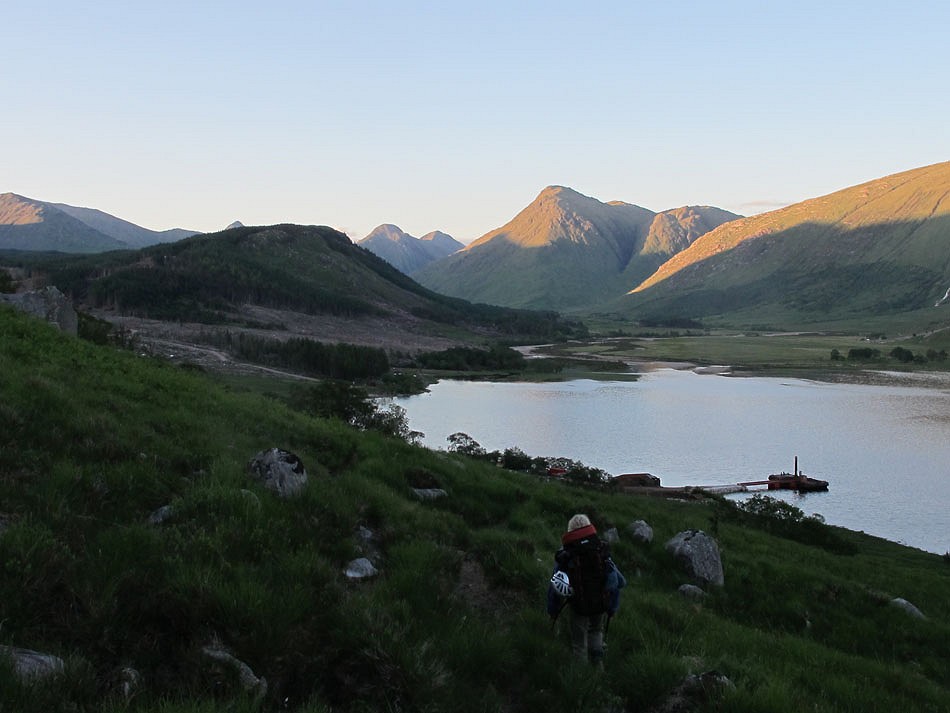
- ARTICLE: So Pumpy for Old Men 24 Dec, 2019
- REVIEW: Belay Devices 25 Jul, 2012
- Rockfax Pembroke 5 Oct, 2009

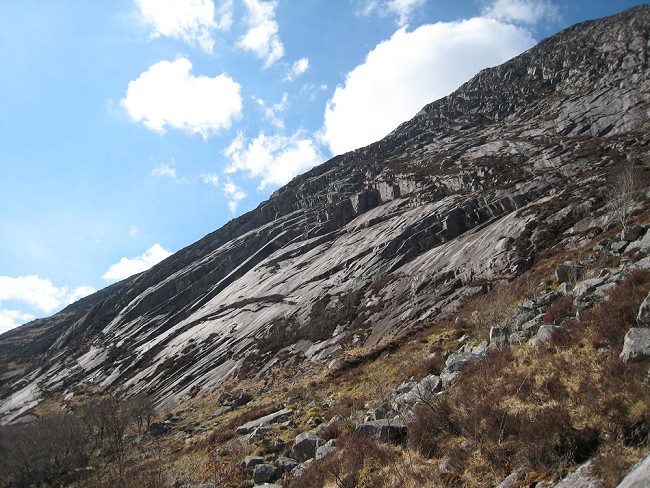

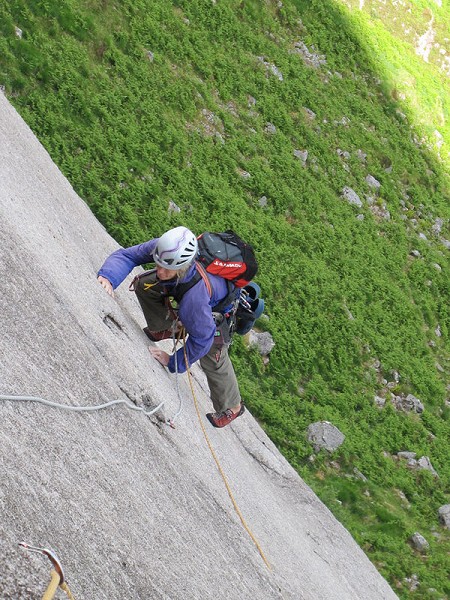
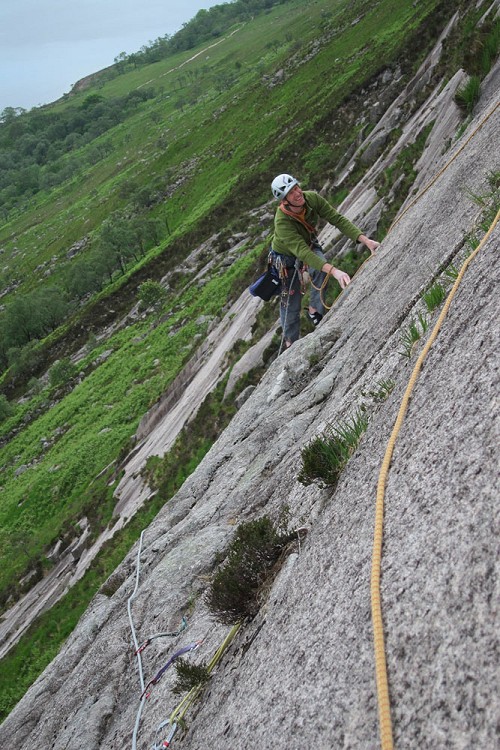
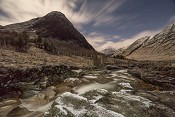






Comments